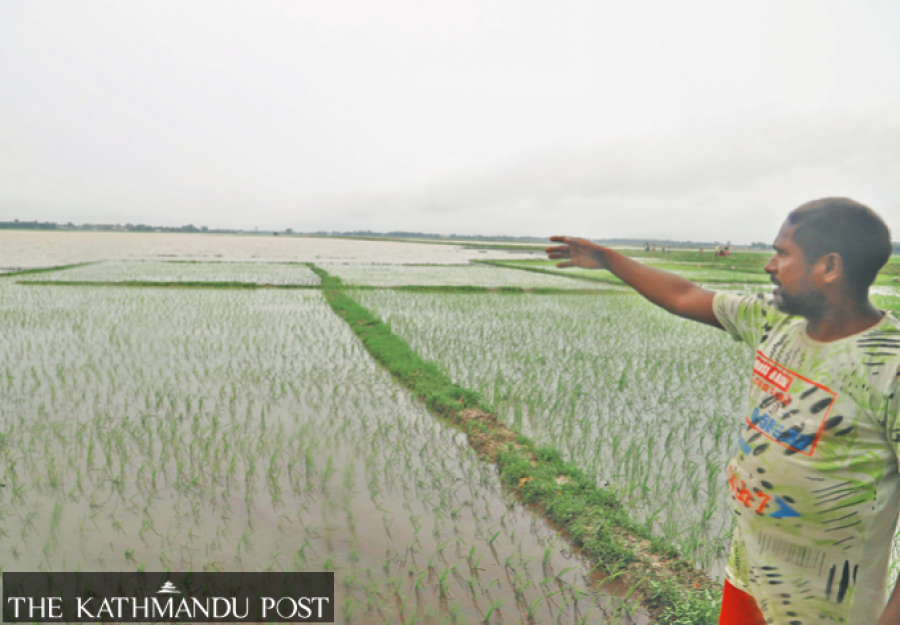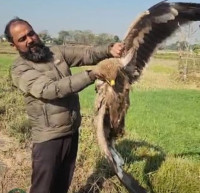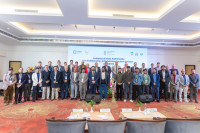National
Nepal must pursue inundation issues with India year round, observers say
It is only during flooding in monsoon that authorities take up this perennial problem and even then the southern neighbour continues to ignore concerns.
Binod Ghimire & Anil Giri
Lalji Yadav from Bhagwanpur in Yashodhara Rural Municipality, Kapilvastu completed paddy plantation on his nine bighas of land spending Rs7,000 per bigha (equivalent to 0.675 hectares) on farm workers on Monday. It took three days for seven labourers to complete the plantation.
But since Wednesday his entire paddy field has been inundated.
“Everything has been destroyed now,” he said. “I cannot even locate the paddy field due to the water.”
Fursat Dhuniya’s three bighas of land are also inundated.
Theirs are among the hundreds of hectares of paddy fields in Yasodhara Rural Municipality, Kapilvastu district submerged under water due to the Mahalisagar barrage erected by India.
The Indian authority closed the outlets of the barrage built on Masaiya stream as its water level increased, leading to inundation in Bhagwanpur, Rangpur, Bhainsaiya and Loharauli villages under the rural municipality.
“The newly transplanted paddy saplings have rotten now, resulting in a loss of millions of rupees,” Grijesh Kumar Pandey, chairperson of the rural municipality, told the Post. “This is our perennial problem.”
The Indian authority has constructed a barrage on the stream less than a kilometre away from the Nepal-India border.
According to Buddhi Narayan Shrestha, an expert on border issues, the international practice is that the bordering countries don’t construct any structures that block the natural flow of a river 15 kilometers downstream and upstream of the border.
Pandey said they have been raising the issue for years but it has not been resolved because the federal government hasn’t shown an interest.
“This is an issue that needs to be resolved by the two countries. What we can do is request our federal government,” said Pandey. “However, we have no information about any concrete steps it has taken to find the solution.”
Nepal asked Indian authorities last week to open Mahalisagar barrage gates, according to Madhukar Prasad Rajbhandari, director general at the Department of Water Resources and Irrigation.
But apparently it has not been done, to the despair of people like Dhuniya.
“How will I feed my six-member family now?” he said. “Paddy is our main source of survival.”
Inundation in Tarai districts because of dams, embankments, roads and other structures built by the Indians on their side of the border has been a perennial problem, but the issue gets attention in Nepal only when the disaster strikes every monsoon.
This year too, following floods and devastation along the Tarai plains, secretaries of the Ministry of Home Affairs and Ministry of Land Management, Cooperatives and Poverty Alleviation and chiefs of security agencies other than the Nepal Army held a meeting on June 30 to discuss the matter. Joint-secretaries of the two ministries and the Ministry of Froreign Affairs as well as the director general of the Department of Survey were also present at the meeting.
Prakash Joshi, director general of the Department of Survey, made a presentation that dwelt on the impact of India-built infrastructures on the Nepali side.
“The meeting discussed the flooding caused by structures built on the other side of the border and decided to write to India,” said the participant who did not wish to be named.
According to him, following the meeting, the Nepal government has written to the Indian authorities about the problems of flooding and inundation faced by Nepal due to the structures built by India obstructing the natural flow of water.
But observers do not hope much will come out of the correspondence as shown by the inundation in Kapilvastu.
“Our approach is flawed,” said Dwarika Nath Dhungel, a former Water Resources secretary. “We act only when the monsoon arrives. This is why we have been failing to address this issue for decades.”
Dhungel has in the past negotiated with the Indian side at different levels about the flooding caused in border areas.
“A piecemeal approach cannot lead us to a solution,” Dhungel told the Post.
Structures like dams and roads cannot be built overnight and even though India’s unilateral construction is uncalled for, the Nepali side too has completely failed to monitor the goings on in the border areas, according to Dhungel.
A report by the National Human Rights Commission released in May last year pointed out that thousands of people suffer every year due to the inundation caused by dams and embankments constructed unilaterally by Indian authorities. According to the report, this has killed at least 89 people and displaced more than 60,000 in the past two decades.
The report says India has constructed 21 dams and embankments along its border with Nepal in manners that block the flow of rivers downstream. The southern neighbour is also developing a 1,750 kilometre highway, parts of which pass through the no-man’s land between the two countries. The highway which stands 10 feet above the ground level also blocks the flow of the river.
Govinda Sharma Poudyal, a former member of the commission who visited the field to collect information for the report, says successive governments have paid little attention towards resolving the problem.
“The government seems to be working to find a solution only when the problems emerge with the monsoon rains. The issue subsides after the rainy season,” he told the Post. “In fact no government has taken concrete steps in finding a permanent solution to the grave problem.”
Although there are district-level mechanisms in both the countries to monitor and resolve such issues, they are ineffective, he said.
“Chief district officers and other officials representing Nepal have a sense of inferiority complex when they attend meetings and therefore they cannot put forth their concerns effectively,” Poudyal said.
Other mechanisms to discuss issues related to the border have also been ineffective in resolving the problem.
“From chief district officer level to foreign minister level, we have at least half a dozen mechanisms to deal with issues related to border security, management, water resources, irrigation, inundation and flood management and we keep on communicating to them,” a senior security official said on condition of anonymity. “But we have failed to reach any concrete understanding with India to resolve the issue.”
As far as Nepal’s state mechanism is concerned, it is doing its part, say bureaucrats.
“As soon as the monsoon begins, we have taken up the matter with the Indian side through our channels and the Indian Embassy in Kathmandu,” said Rajbhandari of the Department of Water Resources and Irrigation. “We have asked them to keep open the gates of major barrages like Koshi, Gandak, Sarada, Laxmanpur, Mahalisagar and other structures. If they open the gates of these structures and barrages, then chances of waterlogging on our territory will be less.”
He said that Nepal and India have also agreed to build embankments on three more rivers—Khado in Saptari, Badganga in Kapilvastu and West Rapti in Dang and Banke to help prevent floods, inundation and waterlogging in the Nepali territory. India has already completed river training projects on Lalbakaiya in Rautahat, Bagmati in Sarlahi and Kamala in Dhanusha rivers in Nepal for flood control and water resource management.
Information on the extent of the problem at present is also being collected, according to a Home Ministry joint-secretary who attended the June 30 meeting.
“We have also recommended line agencies that are on the field like Nepal Police, Armed Police Force and the National intelligence Department to coordinate with each other in such crucial matters and bring issues to the notice of the ministries so that we can take up the matters with India,” the joint-secretary told the Post on condition of anonymity.
But collection of such information has not been enough as far as people like Yadav and Dhuniya of Yashodhara Rural Municipality, Kapilvastu are concerned.
“After the rains stop and throughout winter we stop taking up the matter but when monsoon arrives and waterlogging starts the issue always becomes a hot topic and we look desperate writing diplomatic notes to India seeking its intervention,” the senior security official told the Post. “No concrete progress has been made in the last several years.”
But according to Dhungel, the former secretary, it is not just recent governments that have failed in addressing the issue.
“Successive governments did not care about what was happening on the border,” said Dhungel. “Neither do we have any long-or short-term vision on how to address this perennial issue. We do not have an institutional memory of what had happened in the past or who did what.”
On the other hand, India strategically feeds the news to its media saying it faces floods and inundation due to the water released by the Nepali side, said Dhungel.
Meanwhile, more construction is going on on the Indian side of the border.
Currently, Chhotamuni Gram Panchayat in Darjeeling district is building a 10 metre high and 14 metre wide embankment along the banks of Mechi River that flows in Jhapa district of Nepal. This could create problems from Nakalbanda to Kakarbhitta on the Nepal side.
“Over a decade ago, Nepal-India signed an agreement to avoid such constructions. However, India hasn’t stopped its construction works. It raises the issue strongly when Nepal does not abide by the agreement,” said Shrestha who is also a former director general of the Department of Survey.
On the other hand, the Indian government had objected to the Nepal government’s move to construct the barrage on Rapti River for the Sikta Irrigation Project which is 14 kilometres upstream from the border while the Mahalisagar barrage is less than a kilometre from the border in India.
Nepal suffers heavily from the effects of such constructions.
As per a study by Shrestha, altogether at least 12,000 hectares of arable land is inundated in the rainy season and 1,800 hectares in winter as river water is blocked.
“Nepal should try to find an amicable solution to the problem by expediting negotiation which it hasn’t done. Different layers of mechanisms formed to address the issue should be activated around the year,” he said. “Being a friendly nation, India should understand the problem facing the Nepali people and that is its international obligation as well.”
According to experts on diplomatic affairs, as Nepal and India share an extraordinary relationship, the issue must be addressed before it becomes complex.
“While India must be sensitive about the problem, Kathmandu must feel the pain of the people in the bordering areas and fulfil its responsibility towards its people,” said Mrigendra Bahadur Karki, director at the Centre for Nepal and Asian Studies. “The relation of roti and beti [food and marriage] between Nepal and India is directly linked with the people from the bordering areas. A time could come when the people who actually share the relationship with India will lose their patience because they are the ones who are facing the problem.”
(Manoj Paudel in Kapilvastu contributed reporting.)




 10.12°C Kathmandu
10.12°C Kathmandu
















